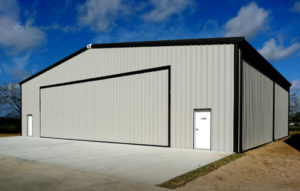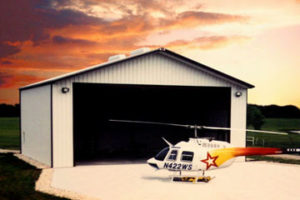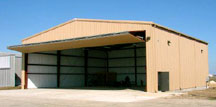Using Steel Aircraft Hangars to Protect Your Flying Assets
 A prefab steel airplane hangar shelters an aircraft from the elements. In addition, sturdy metal hangars protect mechanics as they perform crucial safety checks and maintenance.
A prefab steel airplane hangar shelters an aircraft from the elements. In addition, sturdy metal hangars protect mechanics as they perform crucial safety checks and maintenance.
After all, a plane is a sizeable investment. Naturally, you want the strongest shelter possible for the security of such a valuable asset. And the best protection is a prefabricated hangar from RHINO Steel Building Systems.
RHINO Aircraft Hangars: The Stronger, Safer, Smarter Airplane Buildings
 Ever since man began dreaming up ways to fly, he has needed a place to repair and protect his flying marvels. Thus, plane hangars were born.
Ever since man began dreaming up ways to fly, he has needed a place to repair and protect his flying marvels. Thus, plane hangars were born.
In fact, the Wright Brothers built the first airplane hangar in 1902 at Kill Devil Hills, North Carolina.
Unfortunately, they built their landmark hangar with wood.
After completing the construction of their Wright Flyer in Ohio, they returned to find their wooden hangar in North Carolina destroyed by storms.
It is easy to see why engineers so quickly switched to metal hangars.
Today, everyone knows steel is far stronger than wood.
A Little Metal Hangar History
Steel’s superior strength allows spans of much greater distances than a wood building. That’s why steel is the material of choice for bridges, mega-warehouses, large manufacturing facilities— as well as aircraft hangars.
Actually, steel was the material of choice for the massive hangars needed for the early dirigibles.
For example, “Hangar No. 1” built in Lakehurst, New Jersey is framed with steel. Constructed in 1921, this monster structure contains 211,000 sq. ft. of floor space. Equally shocking, it soars to an amazing 172’ in height.
Almost 100 years later, Hangar No. 1 still exists. In fact, it is a registered national monument.
What a testament to the functionality, versatility, and durability of steel!
(Check out this incredible video about the construction of the USS Shenandoah in Hangar No. 1.)
The Many Advantages of a Steel Airplane Hangar
 Durable prefab metal hangars resist damage from termites, mold, high winds, snow, rain, fire, lightning, and even earthquakes.
Durable prefab metal hangars resist damage from termites, mold, high winds, snow, rain, fire, lightning, and even earthquakes.
In addition, the framing for a prefab airplane building consists completely of manufactured components. Therefore, each framing piece arrives welded, punched, drilled, marked and ready to assemble.
The Versatility of RHINO Metal Hangars
RHINO steel buildings suit all aircraft structures, including:
- Aircraft peripheral buildings
- Airfield offices
- Classic biplanes hangars
- Corporate jet hangars
- Crew quarters
- Glider hangars
- Helicopter hangars
- Jumbo jet hangars
- Maintenance buildings
- Small, private plane hangars
- Shade structures
- Terminals
Steel Aircraft Hangar Options
 Customize your hangar with massive doors, overhead cranes, or mezzanines. Whatever you need to make the building right for your aviation application, you will find it at RHINO.
Customize your hangar with massive doors, overhead cranes, or mezzanines. Whatever you need to make the building right for your aviation application, you will find it at RHINO.
For example, RHINO offers hangar doors in several styles. Choose from sliding, vertical lift, and bi-folding door systems.
In addition, hangar door options include manual, electric, and hydraulic lifting systems.
Furthermore, you may order all our hangar doors with additional wind resistance up to 145 mph. Insulated doors are also available.
Other quality-conscious metal building options to consider include:
- Pro-Value insulation package
- Skylights and wall lights
- Standing seam steel roof panels
- “Cool” reflective exterior panels
- Vapor barriers
- Vents
- Wall panels and partitions
Conclusion
Nothing beats a RHINO-tough airplane hangar for guarding your aircraft from harm.
Choose RHINO Steel Aircraft Hangars and Metal Buildings
Let RHINO design an affordable steel plane hangar for your specific needs. Our metal hangars and metal buildings will meet or exceed all your current local building codes for the lifetime of the structure— guaranteed.
Your aircraft deserves the best protection available—and that is RHINO’s steel structures. See The Rhino Difference for yourself.
For more information or a fast and friendly quote, call RHINO at 940.383.9566 now.
(Updated 12-18-2019. Originally published 3-11-2013.)
